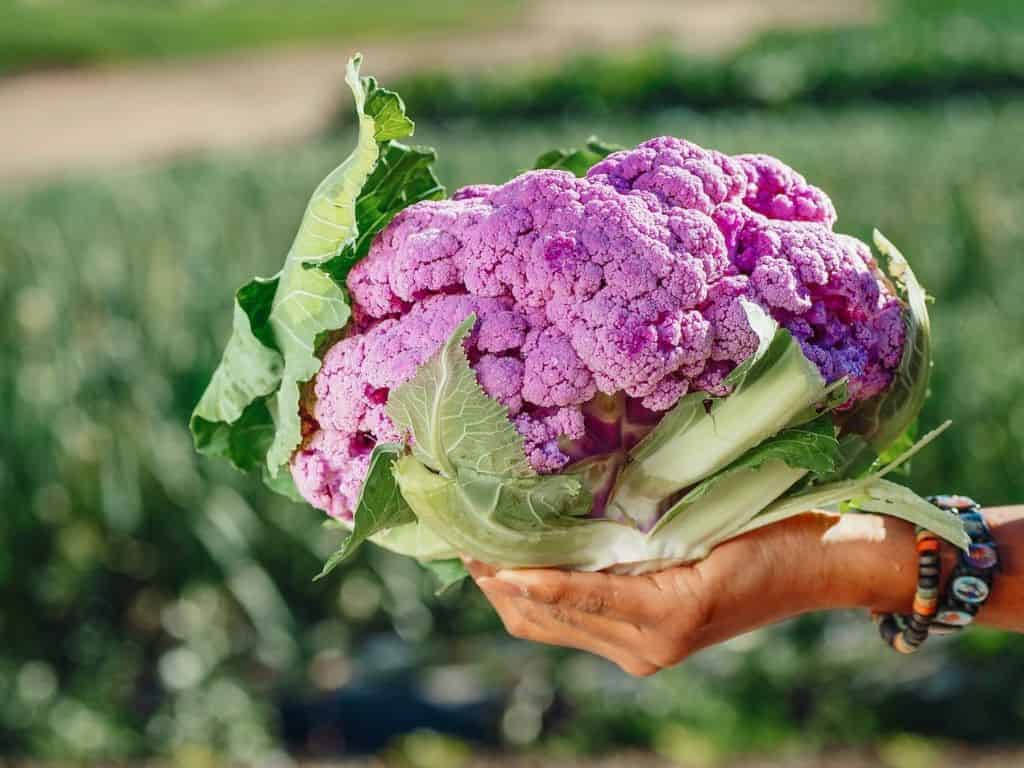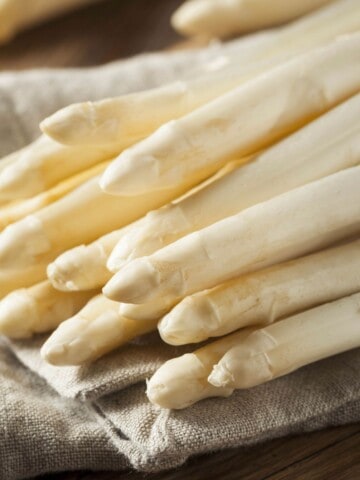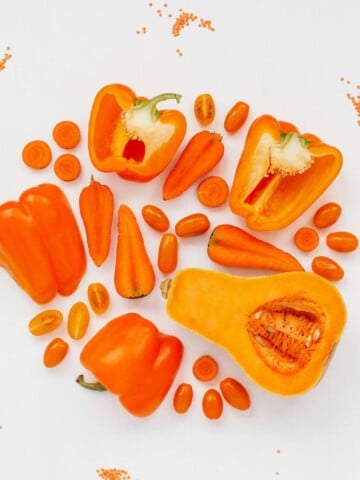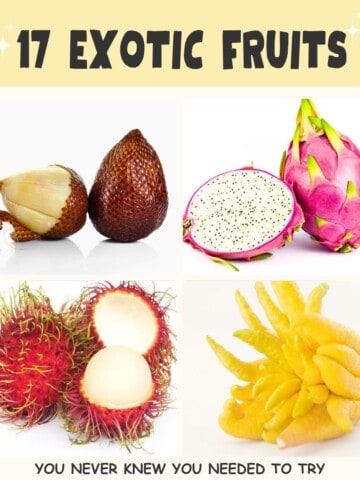"Purple is the New Green"! We're diving into the colorful world of purple vegetables, where we'll introduce you to the top 10 purple champs.
These veggies aren't just delicious, they're also here to prove that purple is the coolest hue in the produce aisle. From eggplant to purple asparagus, we'll unveil their origins, share fun facts, spill the beans on the perfect growing seasons, and serve up ideas on how to enjoy them.

Regarding vegetables, it's not just about eating your greens but also considering the importance of eating a variety of colors. Incorporating a colorful array of vegetables into your diet ensures a diverse range of nutrients and health benefits.
So, forget all the other colors for a moment, and let's paint the town purple.
Jump to:
- Are purple vegetables good for you?
- The Royal Lineup: Top 10 Purple Vegetables
- Cauliflower: The Purple Powerhouse Variety
- Purple Sweet Potato: The Sweet Side of Purple
- Purple Asparagus: Delicate Stalks with a Distinctive Flavor
- Carrots: Rediscovering a Purple Ancient Heirloom
- Purple Brussels Sprouts: Miniature Marvels of Purple Goodness
- Purple Kale: Nutrient-Packed Greens with a Stunning Hue
- Eggplant: The Classic Purple Delight
- Purple Cabbage: Crunchy, Colorful, and Packed with Nutrients
- Purple String Beans: Purple Pod Wonders
- Radishes: Zesty, Tangy, and Oh-So-Purple
- More Recipes: Purple Vegetable Edition
- Related Posts
- Comments
Are purple vegetables good for you?
Purple vegetables are unique and special for several reasons.
They are rich in antioxidants, thanks to the anthocyanins (pronounced an·thow·sai·a·nuhnz) that give them their vibrant color. These antioxidants help protect our cells, promoting overall health and reducing the risk of chronic diseases.
Additionally, purple vegetables are nutrient-dense, providing essential vitamins, minerals, and dietary fiber. They contain unique phytonutrients associated with anti-inflammatory properties, improved cardiovascular health, and potential cancer-fighting effects. Purple vegetables' colorful and visually appealing nature adds excitement to meals and diversifies our plates. Furthermore, they have cultural significance in various cuisines and can attract children with their vibrant hues. Overall, incorporating purple vegetables into our diet enhances nutritional value and adds beauty and culinary versatility to our meals.
More on what anthocyanins are
Anthocyanins are a group of water-soluble pigments that belong to a larger class of compounds called flavonoids. These pigments are responsible for the vibrant red, purple, and blue colors in many fruits, vegetables, and flowers. Anthocyanins serve several important plant functions, including attracting pollinators, deterring pests, and protecting plant tissues from harmful UV radiation.
One fascinating characteristic of anthocyanins is their ability to change color depending on pH. In acidic conditions, anthocyanins appear red, while in neutral or slightly alkaline conditions, they appear purple or blue. This pH sensitivity adds to the visual diversity and beauty of these pigments.
It's important to note that anthocyanins are sensitive to heat, light, and pH changes, so cooking or processing these foods can affect their concentration and stability. However, even with some loss of anthocyanins during cooking, these foods retain valuable nutrients and are beneficial for overall health.
The Royal Lineup: Top 10 Purple Vegetables
Here are the top 10 purple vegetables you may want to find today!
Cauliflower: The Purple Powerhouse Variety

- It is typically in season during the cooler months of fall and winter.
- Fun Facts: Purple cauliflower gets its color from anthocyanins, powerful antioxidants. This vibrant vegetable is visually appealing and packed with nutrients like vitamin C and fiber.
- It originated in the Mediterranean and has different varieties, such as Graffiti, Purple Cape, and Sicilian Violet.
- How to Prepare and Eat: Purple cauliflower can be steamed, roasted like in Roasted Miso Cauliflower, or used raw in salads. You can also try it in Roasted Cauliflower Tacos with Romesco Sauce. It retains its color after cooking, making it visually appealing as a side dish or a colorful addition to vegetable trays.
Purple Sweet Potato: The Sweet Side of Purple

- Fun Fact: Purple sweet potatoes are native to Southeast Asia and have been cultivated for centuries.
- Purple sweet potatoes are usually harvested in the late summer and early fall.
- There are various types of purple sweet potatoes, including Okinawan sweet potatoes, Stokes Purple, and Purple Majesty.
- How to Prepare and Eat: Bake, boil, or mash purple sweet potatoes. Their slightly sweet flavor can be utilized in various savory and sweet creations. Use them to make delicious fries, chips, and pies.
Purple Asparagus: Delicate Stalks with a Distinctive Flavor

- Fun Fact: Purple asparagus contains higher levels of antioxidants than green asparagus.
- Purple asparagus has a relatively short season, typically in spring, from late April to June.
- Believed to have originated in the Mediterranean, purple carrots have various varieties, such as Purple Passion and Purple Pacific.
- How to Prepare and Eat: Lightly steam, sauté, grill, or roast purple asparagus for a delicious side dish. Even when cooked, it retains its vibrant color, making it an attractive addition to any dish. Incorporate it into stir-fries for added texture, or use it to enhance the freshness of salads.
Carrots: Rediscovering a Purple Ancient Heirloom

- Fun Fact: Purple carrots were the original color of cultivated carrots, dating back thousands of years. Orange carrots only became dominant in the 17th century through selective breeding.
- Carrots, including purple varieties, are generally available year-round but are at their peak during the late summer and fall.
- Purple carrots have a long history and come in different shades and shapes, such as Purple Haze, Cosmic Purple, and Purple Dragon.
- How to Prepare and Eat: Enjoy purple carrots as crunchy snacks when eaten raw, grate them to add a burst of flavor to salads, or roast them for a delightful side dish. They add a pop of color and a slightly sweeter flavor to any meal. Give purple carrots a try in this recipe for Easy Vegan Glazed Carrots.
Purple Brussels Sprouts: Miniature Marvels of Purple Goodness

- Fun Fact: You might wonder, "Do purple Brussels sprouts taste different than green Brussels sprouts?" The answer is yes. Purple sprouts have a subtle sweetness and milder taste than their green counterparts, along with an earthy and slightly nutty undertone.
- Purple Brussels sprouts are a variation of green Brussels sprouts and are available in varieties like Rubine and Falstaff. In addition, purple Brussels sprouts come from the same lineage as purple (or red) cabbage.
- How to Prepare and Eat: Roast purple Brussels sprouts with a drizzle of olive oil, a sprinkle of salt, and a dash of pepper. Alternatively, chop them up and sauté or steam them to perfection. Use them as a side dish, add them to stir-fries, or incorporate them into salads for a colorful twist.
- Brussels sprouts, including purple ones, are in season during the cooler months of fall and winter.
Purple Kale: Nutrient-Packed Greens with a Stunning Hue

- Fun Fact: The purple color of kale leaves develops when exposed to low temperatures.
- Kale is a hardy vegetable that can resist colder temperatures, so it is often available year-round. However, it thrives during the cooler months of fall and winter.
- It is a hardy vegetable originating in the Mediterranean and comes in varieties like Redbor and Red Russian.
- How to Prepare and Eat: Purple kale can be used in salads, vegan smoothies like Homemade Vegan Mango Kale Smoothie, or as a nutritious addition to vegan soups and stews. It can also be lightly sautéed with garlic and olive oil for a delicious side dish.
Eggplant: The Classic Purple Delight

- Fun Fact: Despite being commonly referred to as a vegetable, eggplants are actually classified as a fruit. This is because they develop from the flowering part of the plant and contain seeds, which are characteristics of fruits. So, the next time you enjoy a delicious eggplant dish, remember that you're savoring a delightful fruit in a savory context!
- Fun Fact 2: Eggplants are called "eggplants" due to their resemblance to eggs. When eggplants were first introduced to Europe in the 18th century, they were white or pale yellow and looked somewhat similar to goose or hen's eggs, hence the name "eggplants" emerged. The term "eggplant" is primarily used in North America and Canada. At the same time, in other parts of the world, such as the United Kingdom and Australia, the vegetable is commonly called "aubergine."
- Eggplants are typically in season during the warm summer months. The exact timing can vary depending on the region and climate. Eggplants generally thrive in temperatures between 70 to 85 degrees Fahrenheit (21 to 29 degrees Celsius). They require a frost-free growing season and plenty of sunlight to develop and ripen properly.
- How to Prepare and Eat: Purple eggplants, commonly found in shades of purple, offer a meaty texture that is great in various recipes, ranging from stews to grilled dishes. Slicing, salting, and grilling them, as well as roasting, are all great ways to enjoy them. They are also excellent in stir-fries and curries for a rich and meaty texture. Try them in vegan eggplant parmesan and baba ganoush.
Purple Cabbage: Crunchy, Colorful, and Packed with Nutrients

- Fun Fact: Purple cabbage belongs to the brassica family, which includes broccoli and kale. It is commonly referred to as red cabbage.
- Cabbage, including purple cabbage, is typically harvested in late fall and winter.
- It is believed to have originated in the Mediterranean and comes in varieties like Red Express and Kalibos.
- How to Prepare and Eat: Purple cabbage can be shredded and used raw in salads, or it can be cooked by stir-frying, sautéing, or braising. It can also be pickled to create tangy and crunchy sauerkraut. Try it in Purple Cabbage Slaw with Creamy Tahini Dressing.
Purple String Beans: Purple Pod Wonders

- Fun Fact: Purple beans are known as "stringless beans" due to their tender texture.
- Beans, including purple varieties, are generally in season during the summer, from late spring to early fall.
- There are different types of purple beans, such as Royal Burgundy, Purple Teepee, and Trionfo Violetto.
- How to Prepare and Eat: To prepare purple beans, trim the ends and steam, sauté, or boil them until tender. Enjoy them as a standalone side dish, add them to stir-fries, or incorporate them into casseroles and soups.
Radishes: Zesty, Tangy, and Oh-So-Purple

- Fun Fact: Some varieties of purple radishes, like the Watermelon radish, have a vibrant purple outer skin and a beautiful pinkish-red interior.
- Radishes, including purple varieties, are primarily available in the spring and fall seasons.
- Purple radishes come in various shapes and sizes, including round, elongated, and daikon-like varieties.
- How to Prepare and Eat: With their vibrant purple skin and crisp texture, purple radishes add a pop of color and a peppery flavor to salads and dishes. You can slice purple radishes in salads and eat them raw to enjoy their crunchy texture and peppery flavor. You can also pickle or roast them for a milder taste, using them in sandwiches or garnish.









Comments
No Comments